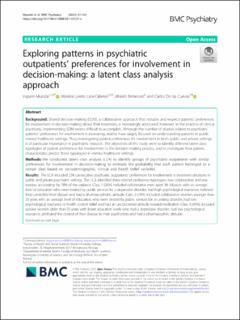| dc.contributor.author | Mundal, Ingunn Pernille | |
| dc.contributor.author | Lara Cabrera, Mariela Loreto | |
| dc.contributor.author | Betancort, Moisés | |
| dc.contributor.author | Cuevas, Carlos De las | |
| dc.date.accessioned | 2021-04-06T14:21:45Z | |
| dc.date.available | 2021-04-06T14:21:45Z | |
| dc.date.created | 2021-03-07T14:39:12Z | |
| dc.date.issued | 2021 | |
| dc.identifier.citation | BMC Psychiatry. 2021, 21 1-12. | en_US |
| dc.identifier.issn | 1471-244X | |
| dc.identifier.uri | https://hdl.handle.net/11250/2736442 | |
| dc.description.abstract | Background: Shared decision-making (SDM), a collaborative approach that includes and respects patients’ preferences for involvement in decision-making about their treatment, is increasingly advocated. However, in the practice of clinical psychiatry, implementing SDM seems difficult to accomplish. Although the number of studies related to psychiatric patients’ preferences for involvement is increasing, studies have largely focused on understanding patients in public mental healthcare settings. Thus, investigating patient preferences for involvement in both public and private settings is of particular importance in psychiatric research. The objectives of this study were to identify different latent class typologies of patient preferences for involvement in the decision-making process, and to investigate how patient characteristics predict these typologies in mental healthcare settings. Methods: We conducted latent class analysis (LCA) to identify groups of psychiatric outpatients with similar preferences for involvement in decision-making to estimate the probability that each patient belonged to a certain class based on sociodemographic, clinical and health belief variables. Results: The LCA included 224 consecutive psychiatric outpatients’ preferences for involvement in treatment decisions in public and private psychiatric settings. The LCA identified three distinct preference typologies, two collaborative and one passive, accounting for 78% of the variance. Class 1 (26%) included collaborative men aged 34–44 years with an average level of education who were treated by public services for a depressive disorder, had high psychological reactance, believed they controlled their disease and had a pharmacophobic attitude. Class 2 (29%) included collaborative women younger than 33 years with an average level of education, who were treated by public services for an anxiety disorder, had low psychological reactance or health control belief and had an unconcerned attitude toward medication. Class 3 (45%) included passive women older than 55 years with lower education levels who had a depressive disorder, had low psychological reactance, attributed the control of their disease to their psychiatrists and had a pharmacophilic attitude. Conclusions: Our findings highlight how psychiatric patients vary in pattern of preferences for treatment involvement regarding demographic variables and health status, providing insight into understanding the pattern of preferences and comprising a significant advance in mental healthcare research. Keywords: community mental health services, latent class analysis, mental disorders, preferences, private mental health service, psychiatry, shared decision-making | en_US |
| dc.language.iso | eng | en_US |
| dc.publisher | BMC | en_US |
| dc.relation.uri | https://doi.org/10.1186/s12888-021-03137-x | |
| dc.rights | Navngivelse 4.0 Internasjonal | * |
| dc.rights.uri | http://creativecommons.org/licenses/by/4.0/deed.no | * |
| dc.title | Exploring patterns in psychiatric outpatients’ preferences for involvement in decision-making : a latent class analysis approach | en_US |
| dc.type | Peer reviewed | en_US |
| dc.type | Journal article | en_US |
| dc.description.version | publishedVersion | en_US |
| dc.source.pagenumber | 1-12 | en_US |
| dc.source.volume | 21 | en_US |
| dc.source.journal | BMC Psychiatry | en_US |
| dc.identifier.doi | 10.1186/s12888-021-03137-x | |
| dc.identifier.cristin | 1896163 | |
| dc.description.localcode | © The Author(s). 2021 Open Access This article is licensed under a Creative Commons Attribution 4.0 International License, which permits use, sharing, adaptation, distribution and reproduction in any medium or format, as long as you give appropriate credit to the original author(s) and the source, provide a link to the Creative Commons licence, and indicate if changes were made. The images or other third party material in this article are included in the article's Creative Commons licence, unless indicated otherwise in a credit line to the material. If material is not included in the article's Creative Commons licence and your intended use is not permitted by statutory regulation or exceeds the permitted use, you will need to obtain permission directly from the copyright holder. To view a copy of this licence, visit http://creativecommons.org/licenses/by/4.0/. The Creative Commons Public Domain Dedication waiver (http://creativecommons.org/publicdomain/zero/1.0/) applies to the data made available in this article, unless otherwise stated in a credit line to the data. | en_US |
| cristin.ispublished | true | |
| cristin.fulltext | original | |
| cristin.qualitycode | 1 | |

